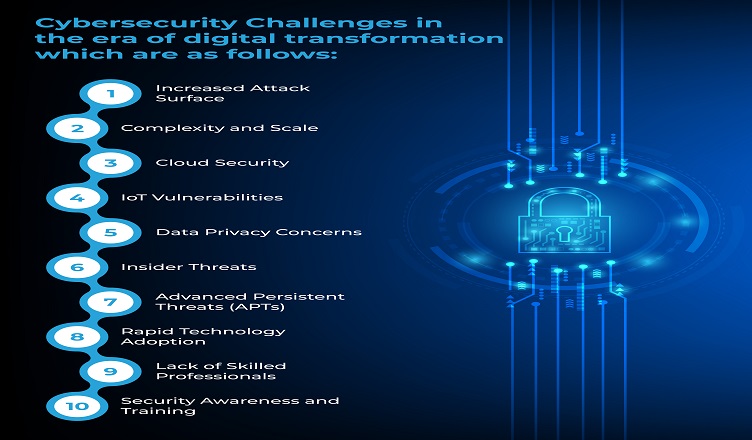The era of digital transformation has brought about significant advancements in technology and business processes, enabling organizations to streamline operations, enhance customer experiences, and increase efficiency.
However, along with these benefits, there are also numerous cybersecurity challenges that have emerged due to the increasing reliance on digital technologies.
Here are some of the key cybersecurity challenges in the era of digital transformation, explained in detail:
- Increased Attack Surface
- Complexity and Scale
- Cloud Security
- IoT Vulnerabilities
- Data Privacy Concerns
- Insider Threats
- Advanced Persistent Threats (APTs)
- Rapid Technology Adoption
- Lack of Skilled Professionals
- Security Awareness and Training
Table of Contents
Increased Attack Surface:
As organizations adopt more digital tools and technologies, the attack surface – the points where a cyberattack can be initiated – also expands.
Each new device, application, or network connection provides an opportunity for cybercriminals to exploit vulnerabilities.
This makes it more challenging for security teams to monitor and protect all potential entry points effectively.
Complexity and Scale
Digital transformation often involves the integration of various systems, cloud services, third-party applications, and IoT devices.
This complexity makes it difficult to maintain a holistic view of the entire digital infrastructure and identify potential security gaps.
Managing security across diverse platforms and technologies can lead to oversight and vulnerabilities.
Cloud Security
Cloud computing is a cornerstone of digital transformation, offering scalability, flexibility, and cost savings.
However, securing data and applications in the cloud requires a different approach than traditional on-premises security.
Misconfigurations, shared responsibility misunderstandings, and inadequate access controls can lead to data breaches and unauthorized access.
IoT Vulnerabilities
The proliferation of Internet of Things (IoT) devices has introduced a multitude of new entry points for cyberattacks.
Many IoT devices have limited processing power and lack robust security measures, making them susceptible to exploitation.
Compromised IoT devices can be leveraged to launch attacks or gain unauthorized access to networks.
Data Privacy Concerns
Digital transformation involves the collection and analysis of vast amounts of data.
Ensuring data privacy and compliance with regulations such as the General Data Protection Regulation (GDPR) or the California Consumer Privacy Act (CCPA) becomes more challenging as data flows across various systems and regions.
Unauthorized data access or breaches can lead to significant legal and financial consequences.
Insider Threats
With increased connectivity and access to sensitive information, the risk of insider threats – both malicious and unintentional – grows.
Employees, contractors, or partners with access to critical systems can intentionally or accidentally compromise security.
Balancing the need for collaboration and data access with security measures is a constant challenge.
Advanced Persistent Threats (APTs)
Cybercriminals are becoming more sophisticated, utilizing advanced techniques to breach networks, remain undetected, and exfiltrate data over extended periods.
APTs can leverage tactics such as social engineering, zero-day vulnerabilities, and customized malware to bypass traditional security measures.
Rapid Technology Adoption
Organizations often adopt new technologies quickly to stay competitive, but this haste can lead to inadequate security measures.
When security is an afterthought, rushed deployments may contain vulnerabilities that can be exploited by attackers.
Security teams must find ways to align with the fast-paced nature of digital transformation.
Lack of Skilled Professionals
The demand for skilled cybersecurity professionals often outpaces supply.
As organizations adopt new technologies, the need for experts who understand both the technology and the associated security risks becomes critical.
The shortage of qualified personnel can hinder an organization’s ability to implement and manage robust cybersecurity measures.
Security Awareness and Training
Digital transformation introduces new tools and processes, requiring employees to adapt and adopt secure practices.
However, without proper training and awareness programs, employees may inadvertently engage in risky behaviors, such as falling for phishing scams or using insecure communication channels.
Conclusion
The Era of digital transformation presents numerous cybersecurity challenges that organizations must address to safeguard their systems, data, and operations.
A comprehensive cybersecurity strategy should encompass proactive risk assessment, continuous monitoring, employee training, secure development practices, and collaboration between IT, security teams, and business stakeholders.
Varixkumar Patel is the Founder and CEO of Software Development company Covrize. His work experience involves playing critical growth in two of the Software Majors of Ahmedabad. He is an expert in planning for optimal resource utilization, proactive hiring, policy formation, employee retention and much more.
